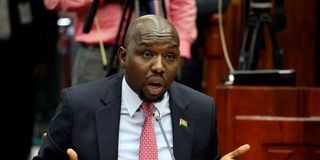Premium
Murkomen should bare all on SGR

Transport and Infrastructure Cabinet Secretary Kipchumba Murkomen. Kenyans want to understand why Kenya Railways was not allowed to participate in developing the terms of reference of the John Hopkins University-based China Africa Initiative study, “Why Mombasa port is not collateral for Kenya’s standard gauge railway.
It is a sign of the times, thanks to new Transport Cabinet Secretary Kipchumba Murkomen, that the standard gauge railway (SGR) loan contracts containing strict non-disclosure clauses are washing around Twitter and news outlets.
The fact that Cabinet ministers have now become the hackers, leakers, and whistleblowers—those who shine a light on the dark corners of classified contracts signed by the government with foreign lenders—is, indeed, a straw in the wind.
It begs several questions. Do the contracts say that China can seize the Port of Mombasa if we don’t pay up? What are the implications of the clauses that stipulate waiver of sovereign guarantees?
Since the terms reveal that Chinese loans are much more expensive than those that we get from the World Bank, the African Development Bank and other multilateral lenders? Or what explains our massive appetite for Chinese loans?
Lastly, has some wrong been put right by dumping confidential Chinese loan contracts on the World Wide Web?
Discerning observers will find little new or shocking information from the contract documents, especially because Mr Murkomen has just scattered the data across the internet without providing the context to the contracts. If you ask me, the information is not that revelatory.
I say so because of the engagement I have personally had recently with an entity known as Aid Data—a research lab based at the College of William and Mary in Virginia, the United States, that maintains a large database on loan contracts by China policy banks in Africa and Asia.
Three years ago, one of the researchers got in touch with me saying he had read my article in this column on the SGR loan contracts and asked whether I could share copies with them. He disclosed to me that Aid Data had so far collected 100 contracts from China Development and China Exim Bank. I politely declined the request.
In November last year, a raging debate exploded in the Ugandan press about how Entebbe International Airport was about to be confiscated for failure to service a $207 million loan issued by China Exim Bank in 2015. That debate more or less died after Aid Data published the confidential contracts between China Exim and Uganda in its portal.
The evidence showed the Ugandans were engaged in what some US-based institutes researching China aid to Africa have recently described, rather derisively, as “China debt trap journalism”. If you have been keenly following this subject, you must have come across a recent study by John Hopkins University-based China Africa Initiative, “Why Mombasa port is not collateral for Kenya’s standard gauge railway.
Got it all wrong
The study makes very condescending, if not derisive, comments about the capacity of our Auditor-General (OAG) to interpret loan agreements correctly. It concludes that the Auditor-General got it all wrong when he concluded in a 2018 letter that Kenya Ports Authority (KPA) was exposed.
Two weeks ago, my contact at Aid Data wrote to comment on a story I penned recently in the Weekly Review that analysed the implications of one of the several SGR contracts which Murkomen did not publish—namely; the ‘take or pay agreement between Kenya Railways Corporation and KPA.
He disclosed to me that Aid Data had managed to access and collect all SGR contracts except the ‘take or pay contract’. The contract Murkomen published was already in the public domain. He should now publish the escrow agreement and the contract under which China Road and Bridge Corporation operates the SGR.
Is Mombasa port, indeed, collateral for the massive Chinese loans? The American researchers say it is not and anybody who says so is illiterate. My contact at Aid Data suggested that the best person to interpret the legal language for me is a Ms Ann Gelpen, of Georgia Town Law School, whom he described as the world’s leading expert on sovereign debt contracts.
I may not be an expert in interpreting complex legal contracts. I choose to go with what I see in the take or pay contract that reads as follows: “The repayment of the principle and payment of interest and fees on the loans are secured, inter alia, by a long-term service agreement (being this agreement) with an aim of guaranteeing a minimum amount of freight throughout the term of the agreements to be charged and received by the operator of the project, which shall be used to secure the repayment of principle and interest.”
Can Murkomen also publish the feasibility study conducted by the Chinese contractor? We want to understand why Kenya Railways was not allowed to participate in developing the terms of reference of this study.
We want details such as the survey report that guided route selection and options, market share forecasts, the financial modelling study report to determine profitability and bankability, and an analysis of transport demand and forecast.
Merely publishing the contracts is not enough.





